#e-power
Course Change for Infiniti As Nissan Throws Out Old Playbook
The course Infiniti plotted to guide it safely through the 2010s met with bad weather and hidden shoals, leaving Nissan’s premium division idled and taking on water. Sales dried up, as did its once-promising partnership with Daimler. Even a restyled compact crossover with an innovative engine failed to raise anyone’s pulse upon its 2018 debut. The thud could be heard for miles.
As it embarks on an austere new midterm plan designed to solidify its financial standing, Nissan has a new course in store for Infiniti. Say hello to the “Nissan-plus” brand.
Thai-market Nissan Kicks E-Power Could Be a Design Omen
Almost every day I go for a walk that takes me up the hill behind my apartment. And on that route, I pass by a black, base model Nissan Kicks parked in my neighbor’s driveway. A value special, for sure, and one with a decent amount of attributes — its starting price being topmost among them.
In a country far, far away, Nissan just introduced an altogether different Kicks, and at least one part of it should make its way stateside.
Nissan Charging Forward on Electric AWD, Solid-state Batteries
The Nissan Ariya Concept seen Wednesday at the Tokyo Motor Show will likely become a reality with little change in outward appearance, but you don’t need a sit-down with a group of Nissan engineers to figure that out. While the company admits an EV crossover is in the cards for the coming year (probably 2021 for the U.S.), the vehicle’s internals remain something of a mystery.
Shedding some light on the vehicle’s underbody bits, the Nissan engineers also opened up on a potentially revolutionary battery technology — as well as a detail that could help hesitant American drivers get behind the wheel of a (mostly) electric vehicle.
Infiniti QX Inspiration: The First Time Ever I Saw Your Face
“I thought the sun rose in your eyes, and the moon and the stars were the gifts you gave … to the dark … and the endless skies, my love,” sang Roberta Flack in the heady and decadent early ’70s. Suffice it to say this writer didn’t feel the earth move in his hand upon gazing at the Infiniti QX Inspiration, not did his heart tremble like a captive bird.
The QX Inspiration, like the Q Inspiration concept of 2018, heralds Infiniti’s electric — or at least electrified — future, and it’s a future without a face.
Nissan Launches Punchier E-Powered Note Nismo S for Japan
Nissan’s performance arm, Nismo, is wetting its beak on electrified powertrains. Last week, the company launched the Note e-Power Nismo S — upping the model’s performance output by roughly 25 percent. Sold in Japan since December of 2016, the Note e-Power Nismo offered 109 horsepower and 187 lb-ft. The new Nismo S brings those specs to 134 horsepower and 236 pound-feet of torque, which Nissan attributes to a tweaked inverter, modified vehicle control module, increased electrical output and an improved reduction drive.
While it’s likely never going to come to North America, there’s a good reason for it to remain on your radar. Nissan is aiming for 1 million sales of fully electric and e-Power vehicles annually by 2022. It’s also going to expand its e-Power system to Infiniti in 2021 and intends to start sending them in our general direction.
Before E-Power Makes It Here, Nissan First Has to Send It to the Gym
Whether the buying public likes it or not, there’s a tsunami of electrified powertrains headed for U.S. shores. Automakers the world over hope to beat their rivals in the race to a “fully electrified” lineup, which just means there’ll be — at a minimum — a hybrid variant in each model line.
It’s far less sexy than headlines make it sound. Still, if you’re into technology and saving money at the pumps (not necessarily at the dealer), it’s hot stuff. Nissan’s taking an unconventional route in this race, forgoing a conventional hybrid setup for an inexpensive stopgap solution all its own.
The system, called e-Power, is already a hit in Japan. But before it makes its way into high-end Nissan products (read: Infiniti), it first needs to upsize the system for American-sized vehicles travelling at American-sized speeds. That’s not as easy as it sounds.
Eight Is Enough: Nissan Leans on Familiar Future Strategy for Growth
Automakers perpetually talk about the future. They have to. As manufacturers, their entire business model revolves around bringing newer, better, and more desirable products to the market. Over the past few years, that has meant championing electric and autonomous vehicles — regardless of whether their consumer base (or the technology) is ready or not.
Nissan is no different in this regard, though it does appear to be taking a comparatively measured approach. Mercedes-Benz says it’ll have an electrified version of all of its models by 2022, Volvo promises to start doing the same by 2019, and Volkswagen Group wants 80 new electric vehicles across all of its brands by 2025. Meanwhile, Nissan is only shooting for eight new EVs by 2022.
That’s not to suggest the company won’t still blaze a trail for new powertrains, though. The strategy may just be a simple matter of not wanting to over-promise. As the company behind the the Leaf, Nissan is well aware of the benefits and pitfalls of a globally marketed electric car. However, its overall sales goal of 1 million electrified vehicles per year by 2022 remains ambitious and hinges on a market more eager for plug-in vehicles than it is today.
Nissan Finally Confirms E-Power for North American Models
After a year’s worth of build-up, Nissan has finally confirmed it will bring its backward-working “e-Power” series hybrid system to the United States. Unlike a conventional hybrid, e-Power drivetrains use an internal combustion engine to generate electricity for an exceptionally small battery. However, the gas-burner doesn’t also drive the wheels — it only runs at a constant speed to charge the battery pack. All propulsion is handled by an electric motor, making the internal combustion unit a full-time “range extender.”
According to the automaker, the end result is a car with the characteristics of a battery-electric vehicle with an exceptional range and no slow-charging plug-in requirements. Cars using the e-Power system don’t even come with an electrical port. Nissan was spotted testing a few Notes equipped with the system last year in Michigan — presumably to get them ready for the North American market. But, despite e-Power seeming like the perfect way to create a low-cost EV (the bizarro hybrid Note retails for $19,000 in Japan), executives are suggesting the technology will initially arrive on higher-priced nameplates.
Join the Club: Infiniti Becomes the Latest Automaker to Go 'Electric'
There’s that misleading word again. At this week’s North American International Auto Show, Infiniti promised it would only field new products featuring some sort of electrified propulsion starting in 2021, thus joining half the automotive universe in promising an “electric” future.
In reality, this means each new model appearing after the target date will launch with at least a hybrid variant in tow. In Infiniti’s case, it means a handful of fully electric vehicles, plus the use of a novel Nissan technology that sees a gasoline engine running at all times.
Nissan Looks Ready to Bring E-Power to Its American Fleet
There’s no confirmation just yet, but all signs are pointing to the eventual introduction of Nissan’s novel e-Power hybrid system in its U.S. lineup.
We say “novel” because the system isn’t like any gas-electric setup currently on the road. Think of it as a way to cheaply reduce emissions without the worries of limited electric range or the expense of bulky battery packs. Instead, think of the car as a little ship.
Nissan Considers Bringing Its Unusual E-Power Technology to America
The success of Nissan’s e-Power system in the Japanese-market Note hatchback has company brass considering a trans-Pacific trip for the technology.
Should it arrive stateside, e-Power stands to give Nissan an edge in low-priced electrification — potentially undercutting the price of compact hybrid rivals by thousands. Unlike conventional hybrids and plug-in models, Nissan’s system burns gasoline every moment of the drive, despite an electric motor doing all the pulling work.
Nissan's 'e-Power' Hybrid System is a Strange Combination of Good and Evil
Nissan has created a strange new backwards working hybrid powerplant that includes an internal combustion engine but doesn’t use it to drive the wheels at all.
It’s called e-Power, it’s going to be in the Japanese-market Note first, and it’s essentially a Nissan Leaf that you don’t ever plug in. It also keeps the oil companies somewhat happy. Allow me to explain…




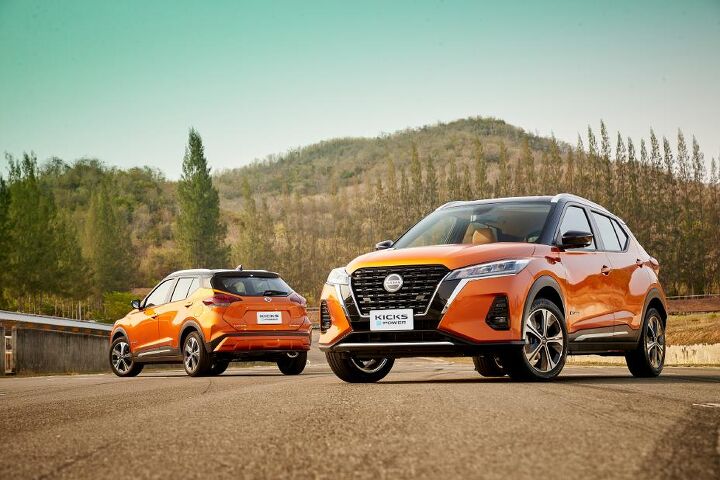
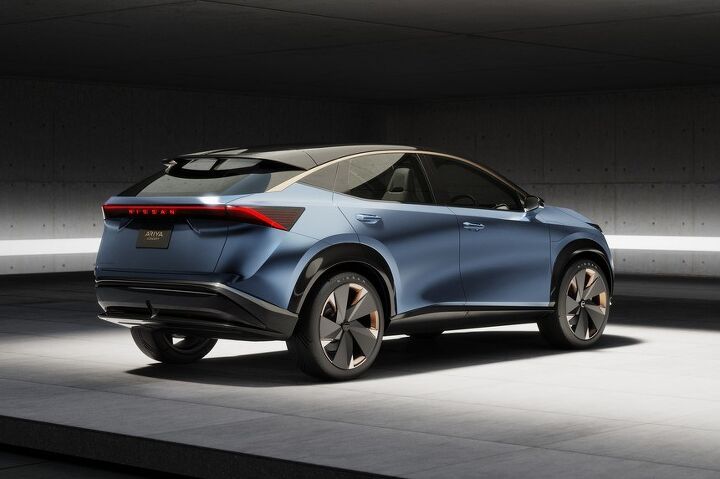



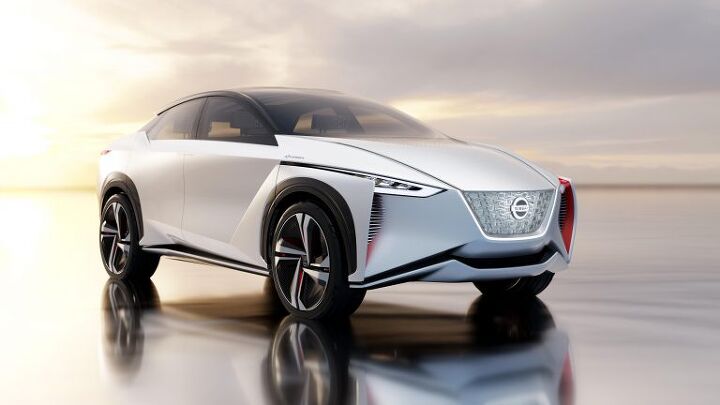
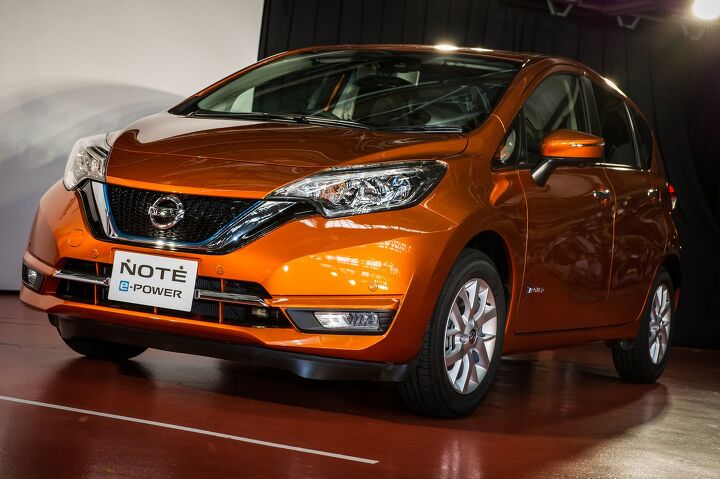



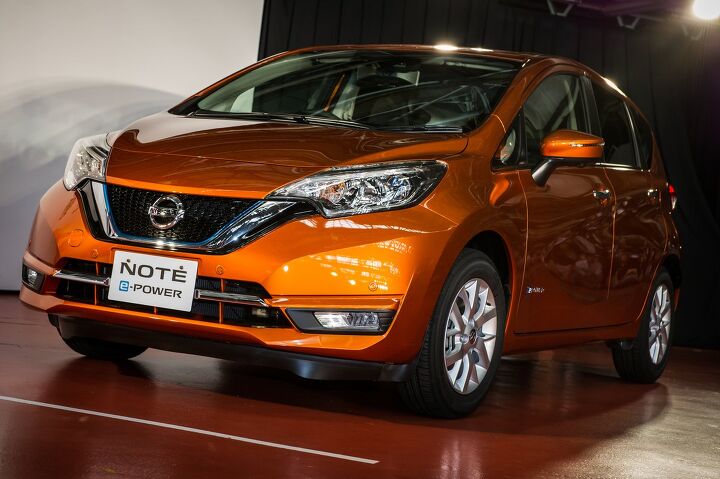












Recent Comments